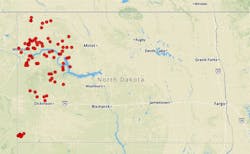Study examines fracking-related spills in four states
DURHAM, NC, FEBRUARY 21, 2017 -- According to a new study, each year, 2 to 16 percent of hydraulically fractured oil and gas wells spill hydrocarbons, chemical-laden water, hydraulic fracturing fluids and other substances. Published today in Environmental Science & Technology, the study looked at 6,648 spills reported across Colorado, New Mexico, North Dakota and Pennsylvania during a 10-year period.
"This study provides important insights into the frequency, volume, and cause of spills," said Lauren Patterson, policy associate at Duke University's Nicholas Institute for Environmental Policy Solutions and the study's lead author.
Researchers examined state-level spill data to characterize spills associated with unconventional oil and gas development at 31,481 wells hydraulically fractured or "fracked" in the four states between 2005 and 2014.
"State spill data holds great promise for risk identification and mitigation," Patterson said. "However, reporting requirements differ across states, requiring considerable effort to make the data usable for analysis."
North Dakota reported the highest spill rate, with 4,453 incidents, followed by Pennsylvania at 1,293, Colorado at 476 and New Mexico at 426. The number of spills reported is partly a reflection of the reporting requirements set by each state. For example, North Dakota required reporting smaller spills (42 gallons or more) than Colorado and New Mexico (210 gallons or more).
Read more about the study here.
